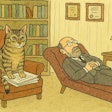
Lab-grown meat as a pet food ingredient draws attention as an alternative to animals. Proponents include advocates for animal welfare and ecological sustainability. The potential for synthetic steaks concerns some ranchers, although most meat alternatives have a long way to go before posing any real threat to pork chops.
As humans explore meat alternatives, I wonder if people will ever look to replace other animals, particularly the ones eating pet foods and treats made by Petfood Industry readers.
Last year, in the fictional Blade Runner world, robotic pets had already replaced real animals. Living creatures had become extremely expensive, replaced by synthetic owls and Burmese pythons. While live snake ownership is not yet a sign of opulence, the costs of taking care of pets has contributed towards pet owners choosing smaller dog breeds or cats. Changing lifestyles also push people towards more low maintenance pets, as people move to cities to work long hours while living in cramped urban apartments. No room for a Great Dane, but maybe a cat. For people with even less time, a turtle can thrive with little social interaction. However, no matter how small or anti-social the pet, you can’t turn a pet off.
Robotic pets could meet modern needs
Like an android, modeled after a human, a zoodroid could take the best qualities of pets, yet never pee on the couch or need boarding during vacation. People could work late or take the kids on one more errand without worrying that the dog was suffering and crossing his legs. Beyond the biological necessities, a doe-eyed, fluffy robot could learn exactly what most amuses its owner by trying millions of behaviors learned from living or fictional animals. Oh, and it could perform chores around the house. Even dogs only vacuum up lost fries, while a zoodroid could clean the rug while you were away.
As artificial intelligence and robotics advance, the idea of synthetic pets doesn’t seem so far-fetched. For example, computer scientists developed a program called AutoML-Zero, reported Science. This software develops artificial intelligence programs without any human help by using principles of biological evolution. Computer scientists put artificial intelligence programs to use solving complex algorithms needed to mimic human intelligence. That made me wonder, could an AI learn to be a cat?
A few years ago, scientists at MIT developed a psychopathic AI, named Norman. To develop an artificial intelligence, humans use data to teach the machine certain mathematical rules and processes, or algorithms. Norman was raised on a steady diet of the nastiest bits of Reddit. The monstrous AI that resulted interpreted Rorschach inkblots in ways that would have scared Rorschach from “The Watchmen.” For example, a blot that looks like a photo of a bird to another AI, looked like a man getting pulled into a dough machine to Norman. (However, it didn’t cackle, “He’s rolling in dough, now,” or “I really kneaded that,” as a human super-villain would have.)
Most cats aren’t quite that vindictive towards humans. To the contrary, the internet abounds with memes and gifs of kittahs. Could computer scientists use all the cute cat videos on YouTube to create an ultra-adorbs AI that would control a synthetic super pet?
Tamagotchis and other digital pets swept the world in the late 90s. People developed real senses of responsibility and attachment to those beeping lumps of plastic. A realistic synthetic pet could elicit even more love. The uncanny factor might be a problem, as with early computer generated images. A slightly fake-looking dog would be creepy, like the humans in the first Toy Story. Exotic or fantastic animals might solve this problem, since people wouldn’t have a frame of reference for realism. Zoodroid designers could exaggerate neotenic features to make a robo-pet so cute it would shame baby Yoda.
Once engineers and programmers solve those technical details, the zoodroid could rise. It seems absurd to think a Furby-1000 could terminate the pet food industry, but many odd, unexpected new technologies ended up changing the world. The robotic pets of today may seem clunky novelties, but so did early horse-less carriages and moving pictures. If you don’t think advanced zoodroids could be a disruptive technology to the pet food industry, try riding a horse to a Vaudeville show tonight.
Resistance is futile.
















